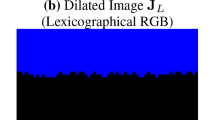Abstract
This paper presents an integration of chamfer metrics into mathematical morphology. Because chamfer metrics can approximate the Euclidean metric accurately, morphological operations based on chamfer metrics give a good approximation to morphological operations that use Euclidean discs as structuring elements. First, a formal definition of chamfer metrics is presented and some properties are discussed. Then, a number of morphological operations based on chamfer metrics are defined. These include the medial axis, the medial line, size and antisize distributions, and the opening transform. A theoretical analysis of some properties of these operators is provided. This analysis concentrates on the relation between distance transformations and reconstructions and the morphological operators just mentioned. This leads to a number of efficient algorithms for the computation of the morphological operators. All algorithms (except for the opening transform) require a fixed number of image scans and are based on local operations only. An algorithm for the opening transform that is 50–100 times as fast as the brute-force algorithm is presented.
Similar content being viewed by others
References
C. Arcelli and G. Sanniti di Baja, “A width-independent fast thinning algorithm,”IEEE Trans. Patt. Anal. Mach. Intell. vol. PAMI-7, pp. 463–474, 1985.
C. Arcelli and G. Sanniti di Baja, “Finding local maxima in a pseudo-Euclidean distance transform,”Comput. Vis., Graph. Image Process., vol. 43, pp. 361–367, 1988.
G. Borgefors, “Distance transformations in arbitrary dimensions,”Comput. Vis., Graph. Image Process, vol. 27, pp. 321–345, 1984.
L. Dorst, “Pseudo-Euclidean skeletons,” inProc. IEEE 8th International Conference on Pattern Recognition, 1989, pp. 286–289.
F. Groen and N. Foster, “A fast algorithm for cellular logic operations on sequantial machines,”Patt. Recog. Lett., vol. 2; pp. 333–338, 1984.
C. Hilditch, “Linear skeletons from square cupboards,” in B. Meltzer and D. Mitchie, eds.Machine Intelligence 4, University Press: Edinburgh, 1969.
D. Knuth,Sorting and Searching, The Art of Computer Programming, Addison-Wesley: Reading MA 1973.
P. Maragos, “Pattern spectrum and multiscale shape representation,”IEEE Trans. Patt. Anal. Mach. Intell., vol. 11, pp. 701–715, 1989.
G. Matheron, Random Sets and Integral Geometry, Wiley: New York, 1975.
G. Matheron, “Examples of topological properties of skeletons,” inTheoretical Advances, Image Analysis and Mathematical Morphology vol. 2, J. Serra, ed., Academic Press: London, 1988, pp. 217–238.
F. Meyer, “Skeletons and perceptual graphs,”Signal Process., vol. 16, pp. 335–363, 1989.
A. Montanvert, “Medial line: graph representation and shape description,” inProc. IEEE 8th International Conference on Pattern Recognition, 1986, pp. 430–432.
C. Niblack, D. Capson, and P. Gibbobs, “Generating skeletons and centerlines from the medial axis transform,” inProc. IEEE 10th International Conference on Pattern Recognition, 1990, pp. 881–885.
C. Ronse and H. Heijmans, “The algebraic basis of mathematical morphology, part 2: openings and closings,Comput. Vis. Graph., Image Process., vol. 54, pp. 74–97, 1991.
M. Schmitt and L. Vincent,Morphology: Algorithms and Applications, Cambridge University Press: Cambridge, England, to appear.
J. Serra,Image Analysis and Mathematical Morphology, Academic Press: London, 1982.
B. Stewart,Theory of Numbers, Macmillan: New York, 1964.
R. van den Boomgaard and R. van Balen, “Methods for fast morphological image transformations using bitmapped binary images,”Comput. Vis., Graph., Image Process, vol. 54, pp. 252–258, 1992.
B. Verwer, “Local distances for distance transformations in two and three dimensions,”Patt. Recog. Lett., vol. 12, pp. 671–682, 1991.
L. Vincent, “Algorithmes morphologiques à base de files d'attente et de lacets,” Ph.D. thesis, Ecole Nationale Superieure des Mines de Paris, Fontainebleau, France, 1990.
Author information
Authors and Affiliations
Additional information
This research was supported by the Foundation for Computer Science in the Netherlands (SION), with financial support from the Netherlands Organization for Scientific Research (NWO). This research was part of a project in which the TNO Human Factors Research Institute, CWI, and the University of Amsterdam cooperated.
Rights and permissions
About this article
Cite this article
Nacken, P.F.M. Chamfer metrics in mathematical morphology. J Math Imaging Vis 4, 233–253 (1994). https://doi.org/10.1007/BF01254101
Issue Date:
DOI: https://doi.org/10.1007/BF01254101




